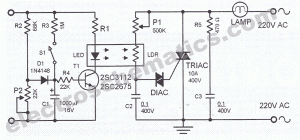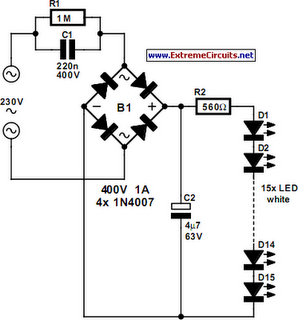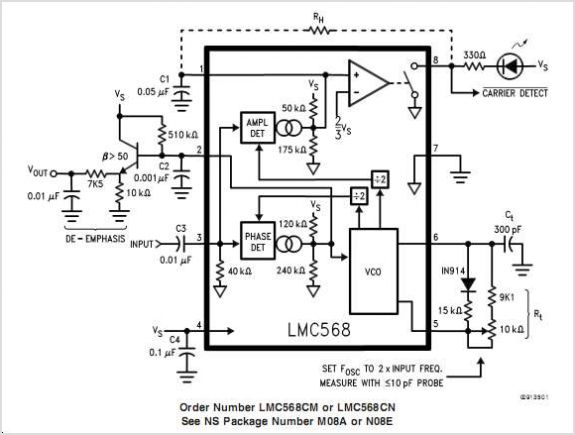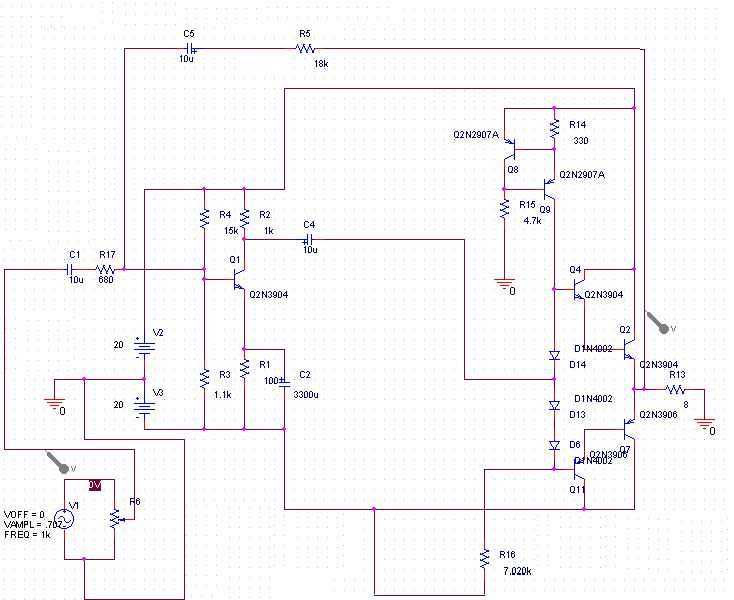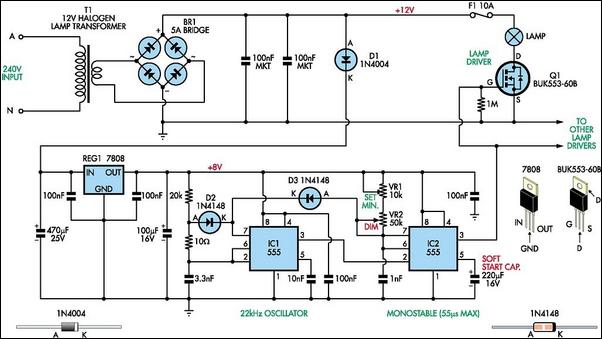
cool chip lt1970 power op amp with current limit
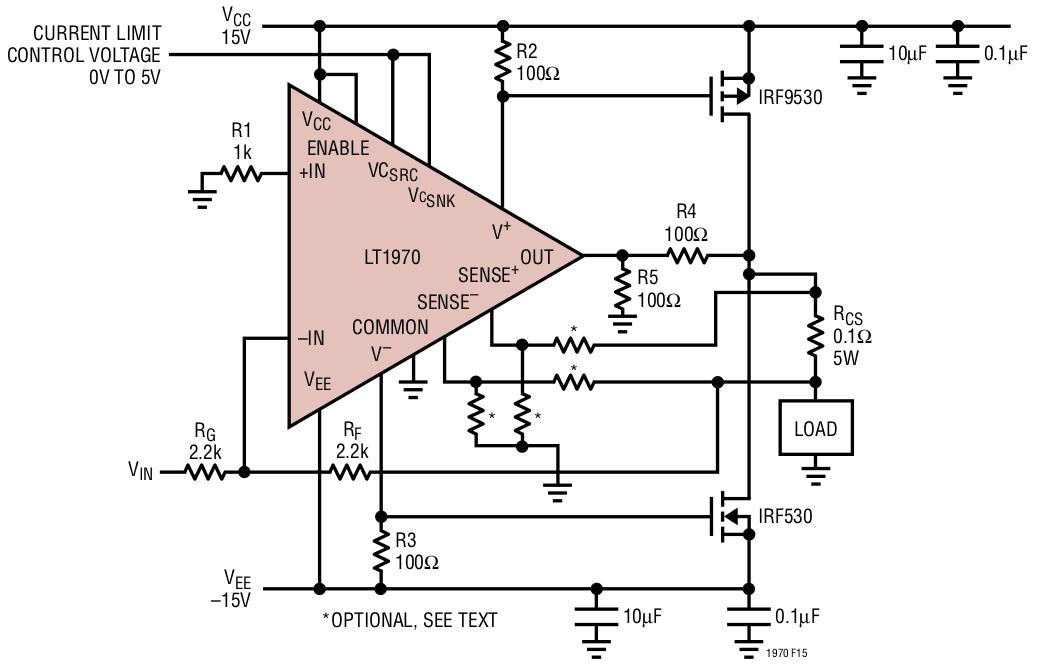
This week, a new favorite chip, the LT1970 power operational amplifier from Linear Technology, is introduced. This device operates from a 36 V supply and can source or sink 500 mA. It features programmable current limiting, outputs for indicating over-temperature and over-current conditions, and functions as a four-quadrant power supply on a chip. A notable feature is the programmable current limit, which has two inputs: one for sourced current and another for sunk current, accepting voltages from 0 V to 5 V. These voltages are compared against the current measured across an external sense resistor, limiting output when the measured current exceeds 1/10 of the voltage on the relevant control pin. Differential input pins, independent of the output pin, are included for the sense resistor. The output stage has its own power pins, allowing the current capability of the op-amp to be boosted by driving external transistors. This configuration enables the output transistors to operate in class AB. The bias current in the transistors is influenced by the op-amp's quiescent current. When the op-amp increases the output voltage, it delivers more current from its power supply, affecting the base voltage of the upper external MOSFET, which in turn sources more current. The same principle applies when the op-amp sinks current. An advantage of using the LT1970 is that all stages, except the output stage, receive a stable power supply, maintaining a high power supply rejection ratio (PSRR). The output stage, combined with external transistors, resembles two Sziklai pairs (or complementary Darlingtons) biased into class AB. The separate power pins facilitate the use of a lower-noise supply for input stages and a high-current supply for the output. In a specific application, the chip was utilized for a wide input range while driving an input sensitive to overvoltage. The input stages operated off 24V, while the output stage was powered from a lower voltage to prevent unsafe output values. Caution is advised, as the V+ and V- must remain within the VCC and VEE supplies for the op-amp's input stages. Additionally, the LT1970 features three open-collector outputs that indicate when the op-amp enters thermal limiting, current source limiting, or current sink limiting, which can drive LEDs for status display. The primary drawback is its package, a 20-pin TSSOP with a thermal pad, requiring specialized soldering techniques. Beyond typical applications, the current-limiting flag outputs can facilitate snap-back current limiting, sharply reducing output current after entering limiting conditions. Current sense pins can also serve as voltage-limit inputs, enabling circuits like a symmetric, voltage-controlled limiter.
The LT1970 power operational amplifier is a versatile component ideal for applications requiring precise control over current flow and voltage levels. Its ability to source and sink current makes it suitable for both power supply and measurement applications. The programmable current limiting feature is particularly beneficial in protecting sensitive loads from overcurrent conditions, as it allows for adjustable thresholds based on the input voltage levels.
The differential input configuration for the sense resistor enhances measurement accuracy by eliminating common-mode noise, ensuring reliable performance in noisy environments. The design of the output stage, which allows for external transistors to be driven directly, significantly increases the output current capability without compromising the operational integrity of the op-amp. This feature is particularly advantageous in high-power applications where maintaining linearity and minimizing distortion is critical.
In terms of thermal management, the LT1970’s thermal limiting outputs provide a proactive approach to preventing overheating, allowing for the implementation of safety measures such as LED status indicators. The design considerations for power supply configurations, including the use of separate power supplies for input and output stages, optimize performance by reducing noise and improving overall efficiency.
The LT1970's package design, while presenting some challenges in soldering, offers a compact solution for integrating high-performance operational amplifiers into space-constrained applications. Overall, the LT1970 is well-suited for applications requiring high precision, reliability, and flexibility in power management and measurement systems.This week I want to share a new favorite chip of mine, the LT1970 power op amp from Linear Technology. This nifty device runs from a 36 V supply and can source or sink 500 mA. That`s not too unusual, but how about programmable current limiting, outputs to indicate over-temperature and over-current, and more Think of it as a four-quadrant power s
upply on a chip, or as the source part of a source measurement unit. The first nice feature of the chip is the programmable current limit. The chip has two inputs, one for sourced current and one for sunk current, that accept a voltage from 0 V to 5 V. It compares these voltages against the current measured across an external sense resistor and limits its output when the measured current exceeds 1/10 the voltage on the relevant control pin.
Differential input pins, independent of the output pin, are provided for the sense resistor. Another great feature is that the output stage has its own power pins. One of the neater trick circuits out there is to boost the current capability of an op amp by using the power supply pins to drive external transistors. An ordinary op amp without separate power pins can also be used this way, but the bias current of the external transistors will be proportional to the op amp`s quiescent current, which means one will probably need a low quiescent current model.
By pinning out the output stage`s power pins, the LT1970 makes it easier. This circuit ends up running the output transistors in class AB. The bias current in the transistors is controlled, in part, by the quiescent current of the op amp. When the op amp tries to increase the voltage of its output, it will deliver more current to the output, pulling that current from its power supply. That, in turn, changes the voltage on the base of the upper external MOSFET, causing it to source more current as well.
The equivalent happens when the op amp needs to sink current. Another advantage of choosing the LT1970 for this configuration, instead of an ordinary op amp, is that all stages except the output stage will see a stable power supply, keeping the PSRR up where it belongs. As for the last stage, when combined with the external transistors, it resembles two Sziklai pairs (also called complementary Darlingtons ) biased into class AB.
The separate power pins also make it easy to use a lower-noise supply for the input stages and a high-current supply for the output. I used them for another purpose: My application needed a wide input range but drove an input sensitive to overvoltage.
Running the input stages off of 24V and the output stage from a lower voltage ensures the output will not hit an unsafe value. Watch out, though, because V+ and V- must be within the VCC and VEE supplies to the op amp`s input stages.
Another neat feature is three open-collector outputs that indicate that the op amp has gone into thermal limiting, into current source limiting, or into current sink limiting. These pins can drive LEDs for an easy status display. The biggest drawback of the LT1970 is its package, a 20-pin TSSOP with a thermal pad on the bottom. That thermal pad means you pretty much have to have either a hot air or reflow setup to solder it. As you might expect for a part like this, there are ways to use it beyond the obvious. The current-limiting flag outputs can be used for snap-back current limiting, where the output current is sharply reduced after it enters limiting.
The current sense pins can be used as voltage-limit inputs, enabling circuits like a symmetric, voltage-controlled limiter. These ideas are from the data sheet; I haven`t tried my creativity at coming up with other ways to (ab)use the chip.
No, I used the chip for a boring old power supply. It was a two-quadrant supply, though, meaning (in this case) that I needed a positive-output power supply that would either source or sink current to maintain its output voltage. The voltage was c 🔗 External reference
The LT1970 power operational amplifier is a versatile component ideal for applications requiring precise control over current flow and voltage levels. Its ability to source and sink current makes it suitable for both power supply and measurement applications. The programmable current limiting feature is particularly beneficial in protecting sensitive loads from overcurrent conditions, as it allows for adjustable thresholds based on the input voltage levels.
The differential input configuration for the sense resistor enhances measurement accuracy by eliminating common-mode noise, ensuring reliable performance in noisy environments. The design of the output stage, which allows for external transistors to be driven directly, significantly increases the output current capability without compromising the operational integrity of the op-amp. This feature is particularly advantageous in high-power applications where maintaining linearity and minimizing distortion is critical.
In terms of thermal management, the LT1970’s thermal limiting outputs provide a proactive approach to preventing overheating, allowing for the implementation of safety measures such as LED status indicators. The design considerations for power supply configurations, including the use of separate power supplies for input and output stages, optimize performance by reducing noise and improving overall efficiency.
The LT1970's package design, while presenting some challenges in soldering, offers a compact solution for integrating high-performance operational amplifiers into space-constrained applications. Overall, the LT1970 is well-suited for applications requiring high precision, reliability, and flexibility in power management and measurement systems.This week I want to share a new favorite chip of mine, the LT1970 power op amp from Linear Technology. This nifty device runs from a 36 V supply and can source or sink 500 mA. That`s not too unusual, but how about programmable current limiting, outputs to indicate over-temperature and over-current, and more Think of it as a four-quadrant power s
upply on a chip, or as the source part of a source measurement unit. The first nice feature of the chip is the programmable current limit. The chip has two inputs, one for sourced current and one for sunk current, that accept a voltage from 0 V to 5 V. It compares these voltages against the current measured across an external sense resistor and limits its output when the measured current exceeds 1/10 the voltage on the relevant control pin.
Differential input pins, independent of the output pin, are provided for the sense resistor. Another great feature is that the output stage has its own power pins. One of the neater trick circuits out there is to boost the current capability of an op amp by using the power supply pins to drive external transistors. An ordinary op amp without separate power pins can also be used this way, but the bias current of the external transistors will be proportional to the op amp`s quiescent current, which means one will probably need a low quiescent current model.
By pinning out the output stage`s power pins, the LT1970 makes it easier. This circuit ends up running the output transistors in class AB. The bias current in the transistors is controlled, in part, by the quiescent current of the op amp. When the op amp tries to increase the voltage of its output, it will deliver more current to the output, pulling that current from its power supply. That, in turn, changes the voltage on the base of the upper external MOSFET, causing it to source more current as well.
The equivalent happens when the op amp needs to sink current. Another advantage of choosing the LT1970 for this configuration, instead of an ordinary op amp, is that all stages except the output stage will see a stable power supply, keeping the PSRR up where it belongs. As for the last stage, when combined with the external transistors, it resembles two Sziklai pairs (also called complementary Darlingtons ) biased into class AB.
The separate power pins also make it easy to use a lower-noise supply for the input stages and a high-current supply for the output. I used them for another purpose: My application needed a wide input range but drove an input sensitive to overvoltage.
Running the input stages off of 24V and the output stage from a lower voltage ensures the output will not hit an unsafe value. Watch out, though, because V+ and V- must be within the VCC and VEE supplies to the op amp`s input stages.
Another neat feature is three open-collector outputs that indicate that the op amp has gone into thermal limiting, into current source limiting, or into current sink limiting. These pins can drive LEDs for an easy status display. The biggest drawback of the LT1970 is its package, a 20-pin TSSOP with a thermal pad on the bottom. That thermal pad means you pretty much have to have either a hot air or reflow setup to solder it. As you might expect for a part like this, there are ways to use it beyond the obvious. The current-limiting flag outputs can be used for snap-back current limiting, where the output current is sharply reduced after it enters limiting.
The current sense pins can be used as voltage-limit inputs, enabling circuits like a symmetric, voltage-controlled limiter. These ideas are from the data sheet; I haven`t tried my creativity at coming up with other ways to (ab)use the chip.
No, I used the chip for a boring old power supply. It was a two-quadrant supply, though, meaning (in this case) that I needed a positive-output power supply that would either source or sink current to maintain its output voltage. The voltage was c 🔗 External reference
